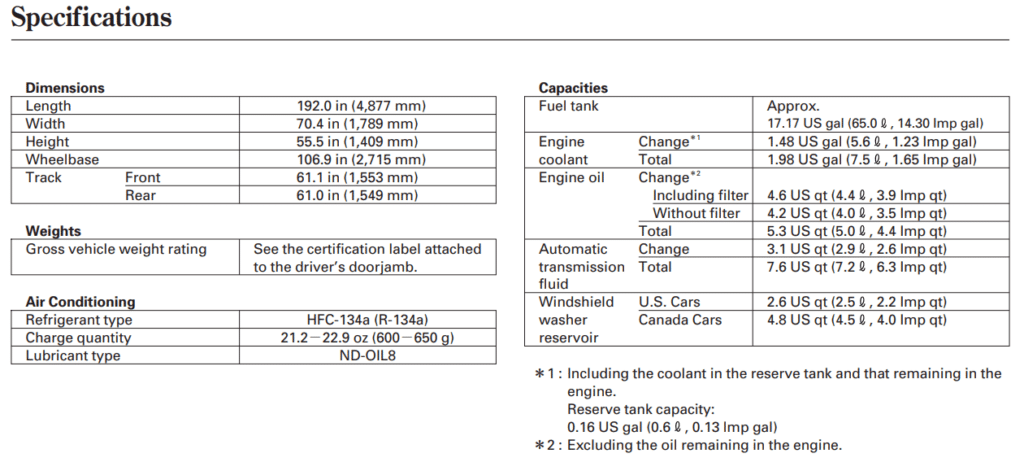The Acura CL, a name synonymous with luxury and performance, has carved a niche for itself in the luxury coupe market. Introduced in the late ’90s, the Acura CL was envisioned as a blend of sporty aesthetics, powerful performance, and the luxury that Acura is renowned for.
Key Takeaways:
| Transmission | Fluid capacity | Fluid type |
|---|---|---|
| 5-speed automatic | Total fill: 7.6 US qt (7.2 L, 6.3 Imp qt) Drain and refill: 3.1 US qt (2.9 L, 2.6 Imp qt) | ATF-Z1 or Dexron III |
| 4-speed automatic | Total fill: 7.6 US qt (7.2, 6.3 Imp qt) Drain and refill: 2.6 US qt (2.4 L, 2.3 Imp qt) | Dexron III |
- Significance of the Acura CL: The Acura CL holds a notable position in the luxury coupe market, offering a blend of performance, comfort, and style.
- Transmission’s Role: The transmission system is vital for the vehicle’s operation, ensuring smooth gear shifts and optimal driving performance.
- Fluid Types and Capacities: Different generations of the Acura CL require specific transmission fluid types and have varying fluid capacities. It’s essential to use the recommended fluid type for each model.
- Symptoms of Depletion: Darkened fluid, slipping gears, unusual noises, and delayed shifting are indicators that the transmission fluid may need changing.
- Common Transmission Issues: The Acura CL, like any vehicle, can face transmission-related problems. Recognizing these early can prevent extensive damage and costly repairs.
- FAQs Addressed: The article provides answers to common questions, from the type of fluid to use to the signs indicating a need for fluid change.
- Cost Considerations: While the cost of changing transmission fluid can vary, regular maintenance can prevent more expensive repairs in the future.
- Proactive Maintenance: Regularly checking and changing the transmission fluid is an investment in the vehicle’s longevity and performance.
- Conclusion’s Emphasis: The importance of regular transmission fluid maintenance cannot be overstated. Acura CL owners are encouraged to stay informed and proactive in their vehicle care to ensure a smooth driving experience.

Over its two generations, the CL has been a testament to Acura’s commitment to innovation, design, and driving pleasure.
But beneath its sleek exterior and plush interiors lies the heart of any vehicle: its mechanical systems. Central to these systems is the transmission, a complex assembly that ensures power is efficiently transferred from the engine to the wheels.
The transmission fluid plays a pivotal role in this process. Acting as both a lubricant and a coolant, the transmission fluid ensures that the intricate components of the transmission operate smoothly, reducing friction and preventing overheating.
Regular maintenance, especially concerning the transmission fluid, is paramount. It not only ensures the longevity of the transmission but also guarantees that the Acura CL delivers the performance it’s known for.
Acura CL Transmission Overview
The transmission system of a vehicle is akin to the central nervous system in the human body. It’s a complex assembly that ensures the engine’s power is efficiently and effectively transferred to the wheels, allowing for smooth acceleration, deceleration, and overall vehicle performance.

In the realm of luxury coupes, the Acura CL’s transmission system stands out, offering drivers a seamless blend of power and precision.
The Acura CL, throughout its existence, has been equipped with automatic transmissions designed to offer drivers both comfort and performance. These transmissions are meticulously engineered to handle the power outputs of the CL’s engines, ensuring smooth gear shifts and optimal fuel efficiency.
The transmission’s primary function is to allow the engine to operate in its narrow range of speeds while providing a wide range of output speeds for various driving conditions. This is achieved through a series of gears that can be shifted as needed, and the transmission fluid plays a crucial role in ensuring these shifts are smooth and efficient.
How Transmissions Have Evolved Over the Two Generations of Acura CL
- First Generation (1997-1999): The first-generation Acura CL primarily came with a 4-speed automatic transmission. This transmission was designed to offer a balance between performance and fuel efficiency. It provided drivers with smooth shifts and was well-suited to the V6 engines that the CL was equipped with.
- Second Generation (2001-2003): With advancements in technology and a push for better performance, the second generation of the Acura CL saw the introduction of a more sophisticated 5-speed automatic transmission. This new transmission allowed for better acceleration, smoother gear transitions, and improved fuel economy. Additionally, the second generation also introduced the Type-S variant, which was equipped with a sportier transmission setup, catering to enthusiasts looking for a more dynamic driving experience.
The evolution of the Acura CL’s transmission system over its two generations reflects Acura’s commitment to innovation and delivering an unparalleled driving experience. By understanding the intricacies of this system, owners can better appreciate the engineering marvel they possess and ensure its longevity through proper maintenance.
Acura CL Transmission Fluid Capacity And Type

1997 – 1999 Acura CL
Typically, Acura vehicles from this era used Honda’s proprietary ATF-Z1 automatic transmission fluid. The average capacity for vehicles of this generation is approximately 7.6 quarts for a complete flush. However, when just draining and refilling, it might be around 3.1 quarts.
2001 – 2003 Acura CL
For this generation, Honda’s ATF-Z1, or its successor, DW-1 automatic transmission fluid, is commonly used. Again, always verify with the vehicle’s manual. The total capacity for a full flush is typically between 7 to 8 quarts. For a standard drain and refill, it’s usually around 2.6 quarts.

Signs Indicating the Need for a Transmission Fluid Change
The transmission fluid plays a pivotal role in ensuring the smooth operation of a vehicle’s transmission system. Over time, due to various factors such as heat, contaminants, and wear, the transmission fluid can degrade, affecting its efficiency and protective properties.
Recognizing the signs that indicate a need for a transmission fluid change can prevent potential damage and costly repairs. Here are some common symptoms suggesting it’s time to refresh the transmission fluid:
- Dark or Burnt Fluid Color: Fresh transmission fluid typically has a bright red color. Over time, as the fluid degrades, it can turn darker, eventually becoming brown or even black. If the fluid has a burnt smell, it’s a clear sign that it needs to be changed.
- Slipping Gears: If the vehicle unexpectedly changes gears or has difficulty staying in gear, it could be due to old or low transmission fluid affecting the hydraulic power needed for smooth gear shifts.
- Delayed or Rough Shifting: If there’s a noticeable delay when shifting from park to drive or if the shifts between gears feel rough or jarring, it might be time to check the transmission fluid.
- Grinding or Strange Noises: A transmission that’s low on fluid might emit a grinding or whining noise. This is due to the lack of lubrication, leading to increased friction between the transmission’s components.
- Surging or Hesitation: Old or contaminated transmission fluid can lead to erratic behavior, such as unexplained surging or hesitation when driving.
- Transmission Overheating: Overheated transmission fluid can cause the transmission to run too hot, leading to premature wear and potential failure. Overheating can be indicated by a burnt smell or even smoke.
- Transmission Warning Light: Modern vehicles come equipped with sensors that monitor the health of the transmission fluid. If the transmission warning light illuminates on the dashboard, it’s a clear sign that something might be amiss.
- Fluid Leaks: If you notice red or brownish puddles under your vehicle, it could be a sign of a transmission fluid leak. Leaks not only indicate a potential problem with the transmission but also lead to low fluid levels, affecting its operation.
Acura CL Transmission Issues
The Acura CL, while being a luxury coupe with a reputation for performance and reliability, has had its share of transmission-related issues, especially in certain model years. Recognizing these issues can help owners address them promptly, ensuring the longevity and performance of their vehicles.
Here’s an overview of some common transmission problems faced by Acura CL owners:
- Transmission Slippage: Some Acura CL owners have reported instances where the transmission unexpectedly slips out of gear. This can be due to worn-out transmission bands or degraded transmission fluid.
- Hard or Delayed Shifting: Difficulty in shifting gears, especially from first to second or second to third, has been a concern. This can be due to a malfunctioning shift solenoid, issues with the transmission valve body, or degraded transmission fluid.
- Transmission Overheating: Overheating can be caused by low fluid levels, clogged transmission fluid coolers, or the use of incorrect transmission fluid. Overheating can lead to premature wear and potential transmission failure.
- Torque Converter Issues: Some owners have experienced problems with the torque converter, leading to shuddering or vibrations when accelerating. A faulty torque converter can also cause the transmission to overheat.
- Transmission Fluid Leaks: Leaks can occur from various parts of the transmission system, including the pan gasket, seals, or cooler lines. Regularly spotting puddles or drips can indicate a leak that needs immediate attention.
- Third Gear Clutch Pack Failures: Some models of the Acura CL have had issues with the third gear clutch pack wearing out prematurely. This can lead to the transmission not being able to shift into third gear.
- Faulty Pressure Switches: Malfunctioning pressure switches can lead to erratic shifting patterns and can throw off transmission error codes.
- Transmission Control Module (TCM) Failures: The TCM is responsible for controlling the shifting of the transmission. A faulty TCM can lead to a range of issues, from erratic shifting to complete transmission failure.
In response to some of these issues, Acura has issued recalls and extended warranties for certain model years. If an Acura CL owner suspects any transmission-related problems, it’s crucial to consult a certified mechanic or dealership to diagnose and address the issue.
Regular maintenance, including timely transmission fluid changes, can also help in preventing many of these problems.
FAQ
1. What Type of Transmission Fluid is Best for My Acura CL?
- For the Acura CL, it’s typically recommended to use Honda’s proprietary automatic transmission fluid, such as ATF-Z1 or its successor, DW-1. However, always refer to the vehicle’s owner’s manual or consult with a certified mechanic to ensure you’re using the correct fluid type for your specific model and year.
2. How Often Should the Transmission Fluid Be Changed in an Acura CL?
- Acura generally recommends changing the transmission fluid every 30,000 miles. However, this can vary based on driving conditions, such as frequent stop-and-go traffic or towing, which might necessitate more frequent changes. Always refer to the maintenance schedule in the owner’s manual for specific intervals.
3. Is It Advisable to Change the Transmission Fluid at Home?
- Changing the transmission fluid at home is possible for those with mechanical experience and the necessary tools. However, it’s essential to follow the correct procedure and ensure the vehicle is safely lifted. If you’re unsure or lack the necessary equipment, it’s best to have the fluid changed by a professional to avoid potential issues or damage.
4. What Are the Indicators That My Transmission Fluid is Depleting?
- Several signs indicate the need for a transmission fluid change, including:
- Dark or burnt fluid color: Fresh transmission fluid is typically bright red, but over time it can turn brown or even black.
- Slipping gears or difficulty in shifting.
- Unusual noises like grinding or whining from the transmission.
- Delayed or rough shifting.
- Transmission warning light on the dashboard.
- A burnt smell, which can indicate overheating.
Regular checks and maintenance can help in the early detection of issues and ensure the longevity and optimal performance of the transmission system. If you notice any of these signs, it’s advisable to consult a certified mechanic.
Conclusion
The transmission system is the backbone of any vehicle, playing a pivotal role in ensuring smooth and efficient operation. For luxury vehicles like the Acura CL, maintaining this system becomes even more crucial to preserve the car’s performance, comfort, and longevity.
Regular transmission fluid maintenance is not just a routine procedure; it’s an investment in the health and lifespan of your vehicle.
Over time, transmission fluid can degrade due to heat, contaminants, and regular wear and tear. This degradation can lead to a myriad of issues, from rough gear shifts to complete transmission failure.
By regularly checking and replacing the transmission fluid, Acura CL owners can prevent these problems, ensuring that their vehicle runs smoothly and efficiently for years to come.
Moreover, being proactive in vehicle care goes beyond just regular maintenance. It’s about staying informed, understanding the signs of potential issues, and addressing them promptly. This not only prevents costly repairs down the line but also ensures that the vehicle remains a joy to drive.
Dear Acura CL owners and enthusiasts, it’s important to take proper care of your vehicle. Your Acura CL is a symbol of both luxury and performance, representing the pinnacle of automotive excellence. To keep it running smoothly and ensure that every drive is as exhilarating as the first, it’s essential to stay informed and proactive, particularly when it comes to transmission fluid maintenance.
By doing so, you can preserve its essence and allow your Acura CL to continue shining. Enjoy the ultimate driving experience!
















